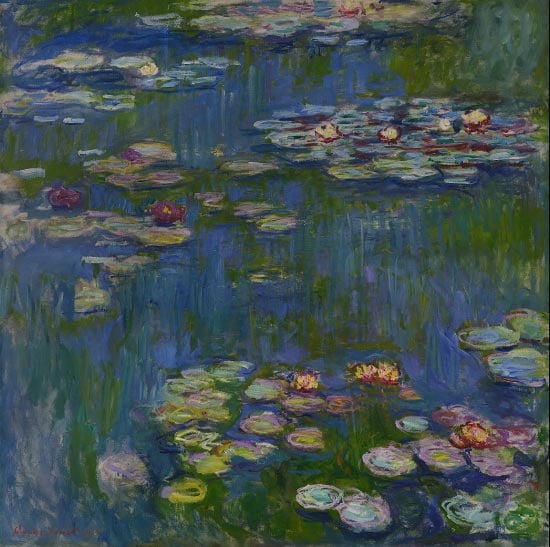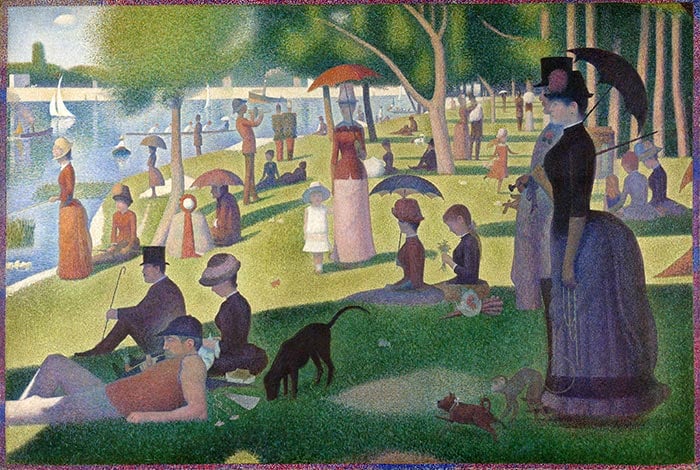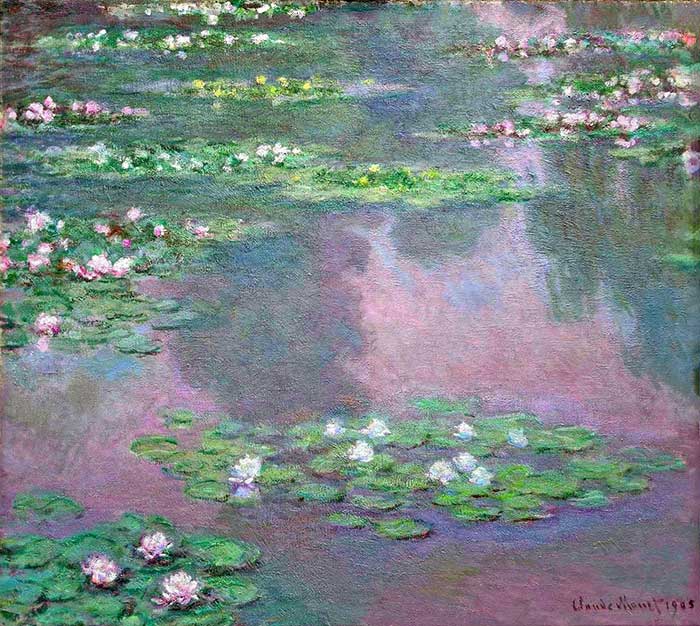How Does One Color Create Harmony in an Art Piece
What Is Harmony in Art?
Harmony is a principle of art which refers to how well all the visual elements work together. Elements which are in harmony should take some kind of logical progression or relationship. Information technology should just wait like it works.
If there is an element which is not in harmony with the rest of the artwork, information technology should stick-out and be jarring to look at; kind of similar an off annotation in a song.
When I think of harmony, the first paintings which come to mind are Monet'southward water lilies series:

Claude Monet, Water Lilies, 1916
Below are some more examples of harmony in art.
Harmony in Color
Harmony in colour refers to paintings which utilize a fairly limited range of hues. For example, a painting which features by and large different tones of greenish, or different tones of blue. Pablos Picasso'south The Erstwhile Guitarist is united by the dull, bluish tones used in the painting. Even the orange guitar looks like it is bathed in soft, bluish light.

Pablo Picasso, The One-time Guitarist, 1904
Monet's painting beneath demonstrates harmony in colour with mostly greens and dejection used. This is known as an coordinating colour scheme.

Claude Monet, The Japanese Bridge (The Water Lilly Pond), 1899
In John Singer Sargent'sFisherwoman, find the like oranges and browns used for both the subject and the landscape. The field of study's clothes about blends in with the shore.

John Singer Sargent, Fisherwoman, 1913
(If you want to learn more about colour, brand certain to take hold of my free Color Theory Cheat Canvass).
Harmony in Shape
Shape is a stiff characteristic in most of Paul Cézanne's piece of work. The painting below from his Mont Sainte-Victoire series is united by the rigid, geometric shapes throughout the landscape.

Paul Cézanne, Mont Sainte-Victoire, 1904-1906
Harmony in Value
Value is a powerful visual element which refers to how light or dark a color is. You tin promote harmony in your painting by uniting colors which are under a tight or compressed value range. For example, a group of calorie-free colors has a certain harmony considering they are all calorie-free. The same goes for a group of night colors or colors within the middle-value range.
The two paintings past Monet below are in a high fundamental and utilise generally lite colors. Even though many unlike hues are used, there is a sense of harmony equally most of the colors are in the low-cal value range.

Claude Monet, Charing Cross Bridge, 1903

Claude Monet, Charing Cross Bridge, 1899
[Do] Place several dissimilar colors on your palette and observe the strong dissimilarity between the colors. And so gradually add together more than white to each color. Detect how when more than white is added, the more in harmony the colors announced to be.
The painting beneath by Joaquín Sorolla, on the other hand, is united mostly under a dark value range, except the burst of low-cal effectually the middle.

Joaquín Sorolla, Packaging of Raisins, Javea, 1901
The painting in grayscale gives a better thought of how night all the colors in shadow are.

Sargent's Val d'Aosta features colors which are by and large around the center-value range. There are no stiff highlights or intense darks.

John Singer Sargent, The Val d'Aosta. Italian republic, 1910
Harmony in Brushwork
Inconsistent brushwork is one of the most common reasons for a lack of harmony in paintings. Beginners tend to jump from tight brushwork to loose and crude brushwork without whatever logical progression.
The painting below by Sorolla features fairly loose brushwork throughout the whole painting which provides a strong sense of harmony. Fifty-fifty areas which are completely different are united past the loose brushwork, like the brilliant, orangish rocks and the deep blueish bounding main. It may have looked out of place had Sorolla carefully rendered the rocks, whilst keeping the ocean loose and rough.

Joaquín Sorolla, Rocks and White Boat, Javea, 1905
Moscow Courtyard, on the other manus, is united by the delicate and careful brushwork throughout the whole painting. Some areas are more simplified than others, just for the nearly part, the brushwork appears consistent.

Vasily Dmitrievich Polenov, Moscow Courtyard,1878
Harmony in Fashion
When I recollect of harmony in style, Vincent van Gogh is get-go to come to mind. His paintings are characterized by bold strokes of exaggerated color.

Vincent van Gogh, Olive Trees Under a Yellowish Sky, and the Nov Dominicus, 1889
Below is another example of harmony in style past Georges Seurat. He utilized a pointillism way, which involved painting modest dabs of distinct color to depict form.

Georges Seurat, Lord's day Afternoon on the Island of La Grande Jatte, 1884
Harmony in Subject
Harmony in bailiwick commonly applies to busy scenes with vast numbers, similar Pierre-Auguste Renoir'due south painting below. Umbrellas and other blue shapes take upward so much of the painting that information technology creates a sense of harmony.

Pierre-Auguste Renoir, Umbrellas, 1886
Monet's water lilies series is another example; the vast number of water lilies creates a sure harmony throughout the painting.

Claude Monet, Water Lilies, 1905
Boosted Resources
If you want to acquire more virtually this topic, you should check out the other principles of fine art.
I also go into much more detail on the fundamentals in my Painting University grade.
Thanks for Reading!
Thank you for taking the fourth dimension to read this post. I appreciate it! Experience free to share with friends. If you want more painting tips, bank check out my Painting Academy course.
Happy painting!

Dan Scott
Draw Paint University
Source: https://drawpaintacademy.com/harmony/
Post a Comment for "How Does One Color Create Harmony in an Art Piece"